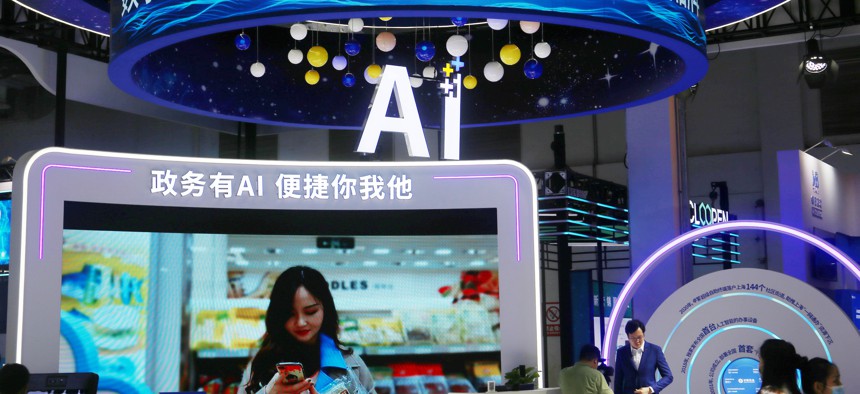
Visitors visit the Waic World Conference on Artificial Intelligence in Shanghai, China, July 7, 2021. Costfoto/Barcroft Media via Getty Images
China’s Aggressive Data Push Worries Military Intel Officials
The AI future runs on data and the Chinese government is out for all it can get.
As Chinese IT and telecom products and services flood marketplaces around the globe, and Western companies rush to gain access to the vast Chinese market, China is gaining access to new streams of data that could help the country better and more quickly engineer new artificial intelligence capabilities, according to the head of intelligence for Indo-Pacific Command.
The growing market for Chinese tech goods has key military and intelligence benefits for the government in addition to financial ones for Chinese companies, said Rear Adm. Michael Studeman, the director of intelligence for INDOPACOM, this week during an INSA event.
As Chinese IT “proliferates around the planet...the access that they have to data allows them to have a larger set of data that they can run, to be able to actually allow machine learning to learn faster,” he said.
Studeman is acknowledging one of the fundamental realities of the new era of artificial intelligence. Many AI methodologies, like neural networks, have been around for decades. But the relatively recent availability of massive stores of streaming data and enterprise-level cloud computing capabilities have made AI much more useful. It’s the difference between a self-driving vehicle that takes five hours to cross a room, (such as the Stanford “Cart” robot, the predecessor to today’s self-driving cars, in 1979) versus a fleet of fully capable autonomous vehicles that pull constant updates from the cloud and traverse wide distances with no trouble. If someone can sell more self-driving cars that can collect data on new conditions, obstacles, etc. then that data can go toward improving all their products with just a quick software update. That’s why having access to large streaming data flows puts companies like Google or Amazon in a strong position to market machine-learning products and services. But what works for large tech companies works for nation states as well.
China already operates vast networks of closed circuit television monitoring that can go to improving facial recognition algorithms, which China has already used to track and police Muslims and other ethnic minority groups. But that’s not the sort of data that would give China a battlefield advantage against the United States.
China’s growing market share of internet search and cloud services is giving Chinese tech companies access to consumer data around the world, which can predict health, economic disruptions, and even civil unrest. For instance, while Amazon, Microsoft, and Google are the largest enterprise cloud providers in the word, China-based Alibaba accounts for 6 percent of the global enterprise cloud market, according to February research from forecasting firm Synergy Research Group. Chinese tech company Tencent owns about 2 percent of the market.
These companies have long said they operate independently of the government, an essential claim since many of them want to be listed on foreign stock exchanges. But in March, China passed new legislation mandating that Chinese tech giants like Alibaba and Tencent share their vast stores of market data with the government.
Western tech companies that want to do business in China must also contend with a 2017 cybersecurity law that mandates that data they collect be stored within the country, where Chinese authorities can access it. That’s putting companies like Tesla in a difficult position, as they need access to the Chinese market to grow their stock price. In May, Tesla set up a new facility in China to host data from its China-based sales and services, despite concerns that Tesla CEO Elon Musk himself has voiced about data privacy in China
Said Studeman, “He or she who has the most data and begins first can learn the quickest and therefore have the information advantage over time.” The proliferation of Chinese tech goods, “plus the intelligence access that they have when they are invited in…will give them a tremendous advantage [in AI and machine learning] and we have to be very attuned to how all of this fits together.”




